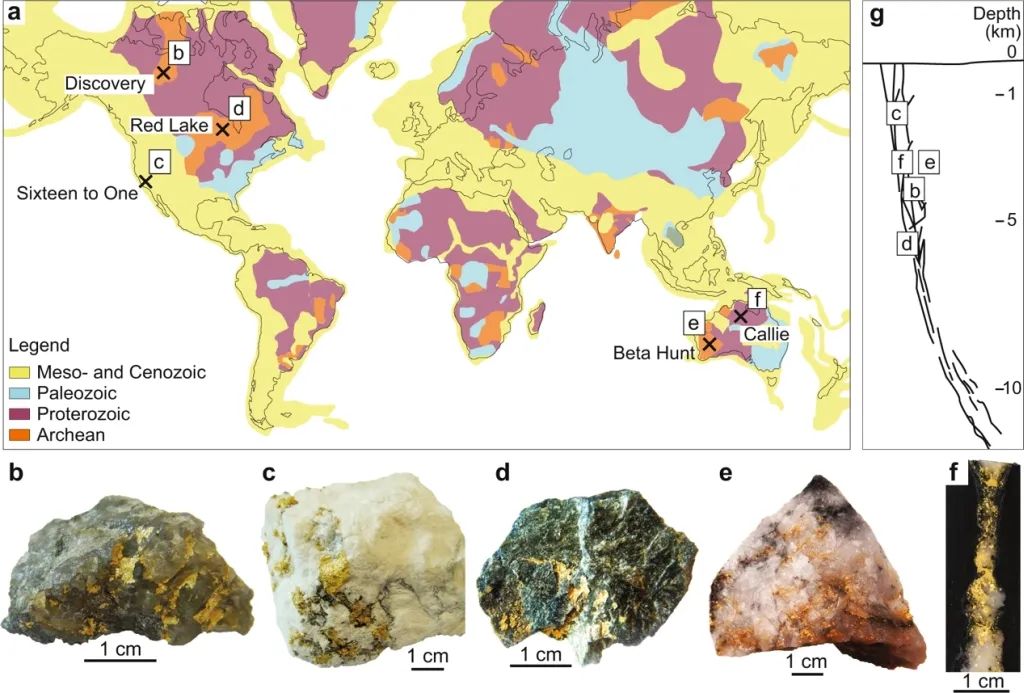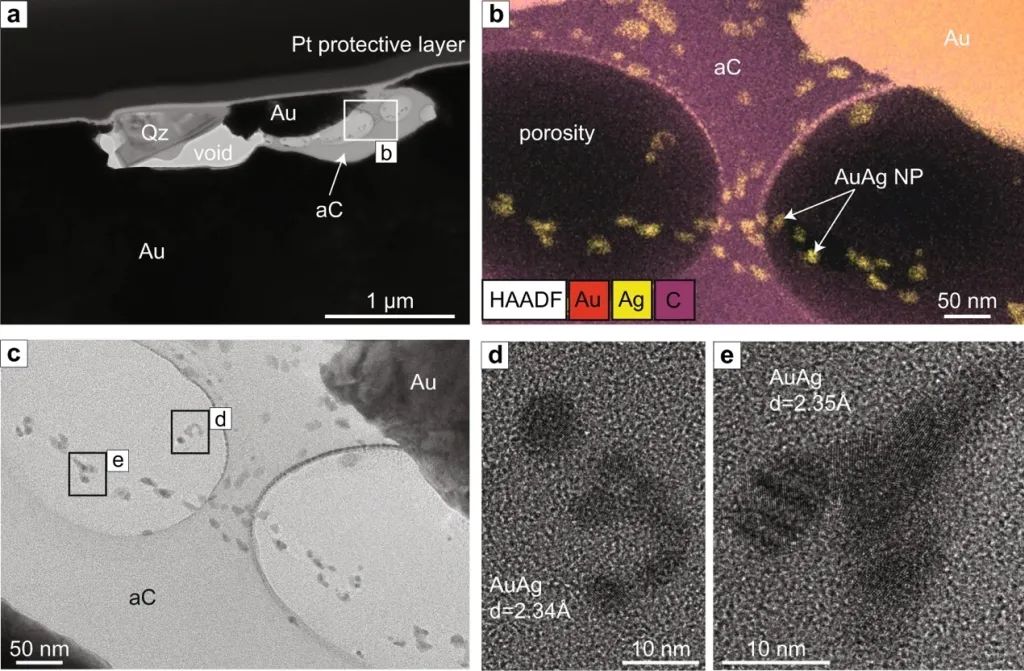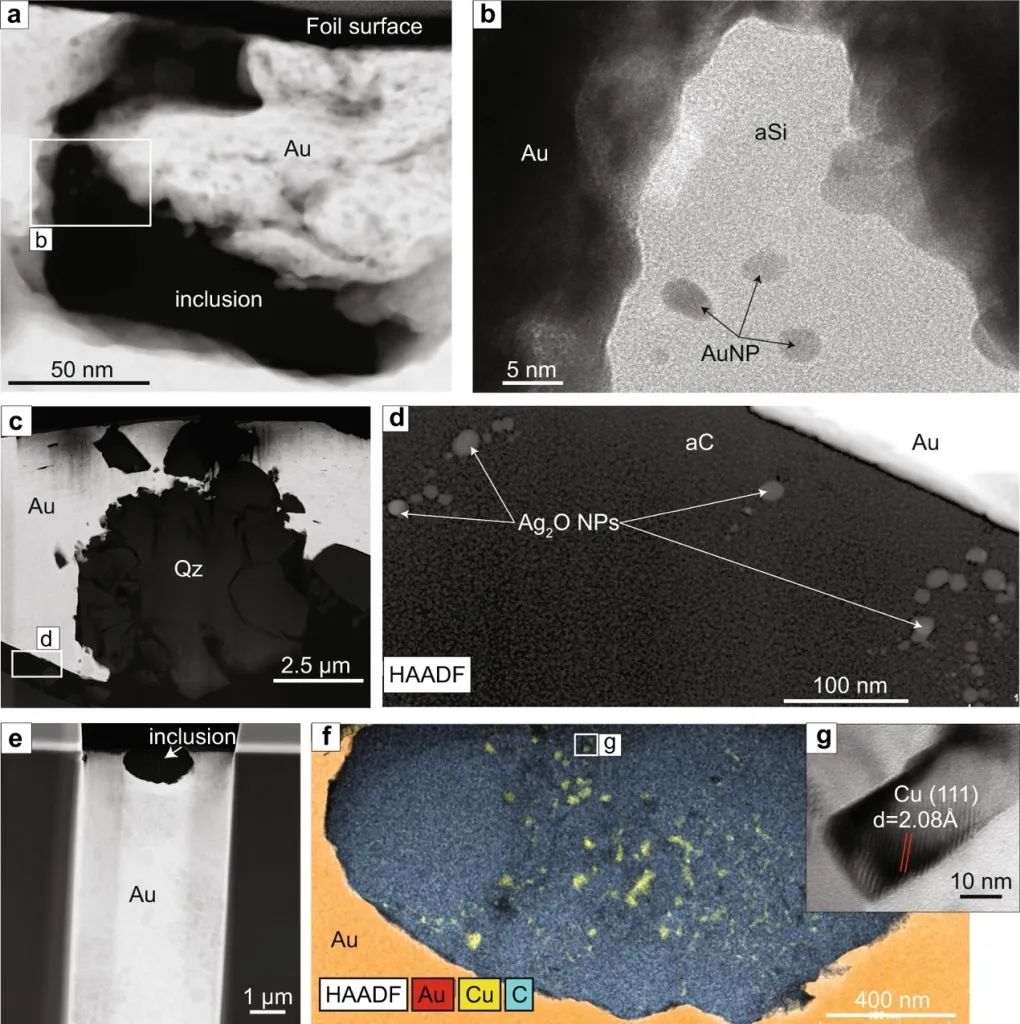NC: Gold in carbon -rich fluids moved with suspended nanoparticles -precipitation is an important reason for forming a high -grade gold mines
Author:Institute of Geological Earth Time:2022.07.20


From 5000 BC to modern times, gold has played a vital role in the evolution of human civilization. Gold is mainly adopted from the gold mines, and the formation of gold mines is mainly controlled by the transportation and mineral precipitation of gold -containing liquid inside the earth. Mountain -type gold ore accounts for more than 75%of the world's gold output, and is usually formed in the upper part of the continental crust. It is characterized by the development of high -quality golden quartz veins. In most mountain-shaped gold mines, the temperature of the mineral fluid is about 250-450 ° C, the pressure is 500-1500 bar, and the salinity is low (usually ≤ 3 wt%naCl EQ.) The value is close to neutral. Some scholars believe that a large amount of fluid repeatedly seeping through faults is a necessary way to form a super high -quality gold (~ 10000ppm AU) ore vein (Weatherley and Henley, 2013). However, the high-grade gold ore veins of some minerals (as shown in Figure 1B-Figure 1F) are narrow (MM-CM level), do not have a layered structure, the eclipse belt is narrow, and the mineral does not have a growth ring belt, indicating that only the only ring belt, indicating that only only A fluid infiltration incident occurred. Mountain -type gold ore -made minerals are mainly transported in the form of complex, and the solubility is generally low. The maximum solubility can only reach hundreds of PPB. Therefore, it is contradictory to form a high -quality gold ore vein with a single fluid event. In order to solve this problem, many recent research work revealed that gold may move in the form of suspended nanoparticles (NP) (E.G., McLeish et al., 2021; petrella et al., 2022). The concentration of suspended nano -gold particles in the fluid is more than 5,000 times higher than that of gold than dissolved substances, providing a feasible mechanism for metal transport in the heat solution.
PetRella et al. (2022) provides direct evidence for the migration of suspended nanoparticles in the gold ore in the mountain -type gold ore. They collected a quartz pulse sample of abnormal high -quality, rich gold (including Mingjin granules) from five gold mines. AU, CU, AU-AG, and AG2O nanoparticles were found in the parcels in gold particles (see Figure 2- Figure 4). The size is between 1-100nm and most of them are below 10nm. Silicon and/or carbon phase.

Figure 1 Sample location and description (PetRella et al., 2022). (A) The location of the sample; (B-F) Fulin quartz pulse sample; (g) Mine formation in-depth schematic diagram

Figure 2 Petrella et al., 2022 in amorphous carbon. (A) High-shaped dark field scanning transmitted electron microscope (HAADF-STEM) images display the quartz (QZ) and amorphous carbon phase (AC) parcel on the surface of the gold foil; Silver gold ore nanoparticles (NPS) in the carbon -rich phase; (C) transmitted electron microscope (TEM) image, the parcel is composed of amorphous carbon phase (light gray) and the NPS (dark gray) it contains. The "bubble" is an empty hole in the amorphous phase;

Figure 3 nano particles in amorphous carbon and silica (Petrella et al., 2022). (A) HAADF-STEM image shows that there is a larger and smaller parcel on the left and right sides of the gold foil; The thin carbon layer at the interface of the gold; (C) TEM image shows that the interface between amorphous carbon (AC) is distributed between amine silicon (ASI) and gold, and many round gold or silver nanoparticles (AU-NP ) Packaged in amorphous carbon phase; (3) High -resolution TEM image shows that 5 nm gold (or silver) NP in amorphous carbon in non -crystal carbon

Figure 4 Gold, silver oxide and copper nanoparticles in amorphous carbon and silicon (Petrella et al., 2022). (A) High-shaped dark field scanning transmission electronic microscope (HAADF -STEM) image; (B) TEM image shows the amorphous silicon (ASI) phase and circular gold nanoparticles (AU-NP) in the parcel; (AU-NP); (AU-NP); c) HAADF-STEM image: light gray crystals corresponding to coarse gold (AU), dark gray corresponding to quartz (QZ), black phase is an amorphous carbon (AC); The round AG2O NP in the phase; (E) HAADF-STEM image shows the parcel on the surface of the gold foil; Display 50 nm CU NP
The key result of this study is that the metal nanoparticles are found closely coexisting with amorphous silicon dioxide and carbon. For the first time,: (1) Metal nanoparticles are closely related to high -quality mountain -type gold mineralization; (2) AU is not a AU is not The only metal in the form of NP, the NP of AG-AU, AG2O, and CU can also be formed in the process of high-quality mountain gold ore mining; There are close connections between phases.
The close space relationship between metal nanoparticles and amorphous silica and carbon-containing phases (see Figure 2-Figure 4) shows that the process of deposits is the same or at least significant. The mining process is shown in Figure 5: In the hot liquid fluid, gold usually forms a complex (AU (HS) 2-, as shown in Figure 5a), and a large number of CO2 can play a role in cushioning pH, so that it can make the pH, so that the pH can make the pH, so that the pH can make the pH, so that the pH can make the pH, so that the pH can make the pH, so that the pH can be cushioned, so The fluid pH maintains neutrality, thereby increasing the stability of the AU-HS complex (PHILLIPS and Evans (2004); , Resulting in a large amount of golden precipitation, or in the form of nano -gold particles, accompanied by silicon glue in the fluid (see Figure 5B), so the carbon -rich fluid is not only conducive to the early gold and wealth transportation, but also promotes a large amount of gold precipitation in the later period. Averse crystal silica may represent the residual silicone remnants that have precipitated during mineralization. These silica gels are the result of coordinating silicon -like silica suspension formed by Weatherley and Henley (2013). A non -crystal carbon -containing phase is likely to be caused by CO2 in the fluid or CH4 oxidation, as well as as an amorphous precipitation. The existence of AG2O nanoparticles shows that a large amount of metal silver has a large amount of oxidation and indicates that the non -crystal carbon may be related to the oxidation reaction during the mineralization process. These oxidation and/or reduction reactions may have a strong impact on hydrogen sulfide (? H2S), causing gold precipitation. The formation of amorphous carbon may occur at the same time as the deposition of silicone during the fluid flashing process (see Figure 5c). During the mineralization process, the escape/removal of the ore vein caused the ore vein to crystallize quartz, so as to discharge the golden nanoparticles from its crystal structure, and then merge to the existing gold particles and grew up. In this process, some amorphous and metal nanoparticles were captured in the coarse gold particles (see Figure 5D). Figure 5 Petrella et al., 2022). (A) The initial unidirectional aquatic carbon mass, containing dissolved metals and acid silicon; (B) single -phase fluid flashing (fluid is not mixed), which causes silicon dioxide and metal nanoparticles to be core; (C C ) Silicone and amorphous carbon precipitation containing metal nanoparticles in the ore vein; (D) Quartz and coarse gold crystals, as well as silicon parcel formation of metal nanoparticles in gold particles formed

Main references (sloping up and downward view)
McLeish D F, Williams-Jones A E, Vasyukova O V, et al. Colloidal transport and flocculation are the cause of the hyperenrichment of gold in nature[J].Proceedings of the National Academy of Sciences, 2021, 118(20): e2100689118.
PetRella L, Thébaw N, Fougerouse D, et al. Nanoparticle Suspensions from Carbon-Rich Fluid Make High-Grade Gold Deposits, 2022, 13 (1): 1-9. 1-9.
Phillips g n, Evans k a. Role of co2in the formation of Gold Deposits [J] .nature, 2004, 429 (6994): 860-863.
Weatherley d k, Henley R W. Flash Vaporization During Earthquakes Evidenced by GOLD DEPOSITS [J]. Nature Geoscience, 2013, 6 (4): 294-298.
Writing: Li Xinghui, Fan Hongrui/Mineral Room

Beautiful editor: Chen Feifei
School pair: Wanpeng
- END -
Wang Yi and Brinken met: an important step for the acceleration of high -level interaction between China and the United States

Regardless of whether the United States is seeking to set up a guardrail for Sino ...
The girl's right leg is stuck under the sewer, the cutting machine is helped

The Yangtze River Daily Da Wuhan Client June 19 (Reporter Xie Binglin Corresponde...